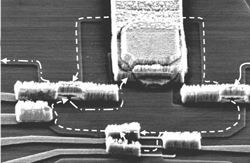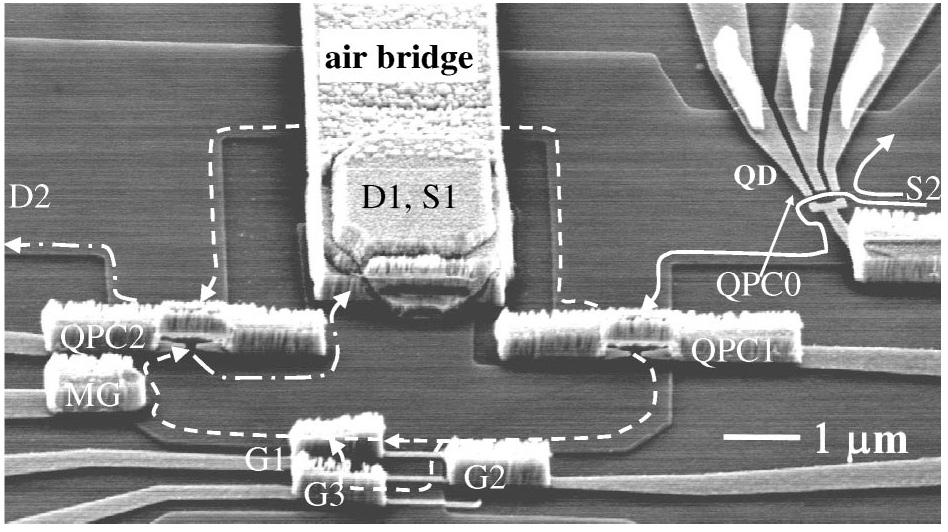The Many Versus the One
The quantum mechanical principle that particles can behave like waves, and vice versa, is a well established experimental fact. But independent papers by two groups in the 16 May Physical Review Letters suggest that the equivalence may not always be straightforward. The researchers provide theoretical explanations for some recent puzzling observations of electrons interfering like waves in an electronic version of the classic double-slit experiment. The electron waves didn’t behave exactly like light waves, they say, because electrons, unlike photons, can interact with one another. These complications may limit the utility of the electron interferometer as a means to explore fundamental physics, but they may also offer insight into new kinds of quantum states.
In the Mach-Zehnder interferometer, devised in the 1890s, a half-silvered mirror splits light into two beams that travel a short distance before being reflected back to recombine at another half-silvered mirror. The light waves interfere at the glass, either canceling or reinforcing each other. When the path lengths are equal, one side of the second mirror is bright, but it goes dark if one beam’s path length is increased by a half-wavelength, because the waves cancel.
A few years ago, researchers devised a Mach-Zehnder interferometer that works with electrons at low temperatures and high magnetic fields. An electric current is split into two paths in a microchip, and the role of half-silvered mirrors is played by ultranarrow “isthmuses” that either allow electrons across or reflect them. As in the optical version, researchers measure the output after the two streams of wave-like electrons recombine.
In 2006 Izhar Neder of the Weizmann Institute in Rehovot, Israel, and his colleagues found some surprises [1]. Using a standard trick, they cyclically increased and decreased the effective length of one of the electron paths, which led to an oscillating output signal, or interference pattern. The output signal hit a minimum every time the two electron waves cancelled and a maximum when the waves maximally reinforced one another. But as they increased the current, the interference pattern waxed and waned in amplitude in an unexpected way, disappearing altogether at certain points. Researchers in France found similar results the following year [2].
If electrons behaved exactly like photons, the interference pattern would not change in this way with the intensity of the electron “beam.” The difference arises because electrons feel each other’s presence through their electric charges, while photons are wholly independent of each other, Neder and his Weizmann colleague Eran Ginossar now argue. As a result, when an electron enters an interferometer path that already contains one or more electrons, the existing occupants have to shuffle about a little to accommodate the newcomer. As more electrons are added, that reshuffling changes the electron waves and alters the interference pattern at the other end of the interferometer. At certain values of electric current interference disappears completely, reappearing again as the current goes still higher.
Heung-Sun Sim of the Korea Advanced Institute of Science and Technology in Daejeon and his colleagues offer a similar argument for the behavior of the interference patterns, although their approach is different. Sim and his colleagues look at how individual electrons react to the presence of others, rather than the collective state of many electrons. Sim says that his team’s approach, although it makes some simplifying physical assumptions, is adequate to address the problem. Neder argues that his and Ginossar’s model offers a fuller picture of the physics–although admittedly it is harder to solve.
Markus Büttiker of the University of Geneva says that these differences in approach arise from the great difficulty in tackling this sort of many-body quantum mechanical problem, in which the simultaneous and collective behavior of several electrons is the crucial factor. Both papers make assumptions whose validity is not easy to judge, he says, although the fact that they both agree relatively well with experiments suggests that the basic physical idea is correct.
The electronic Mach-Zehnder interferometer’s behavior is complex, compared with the optical version–even the new theories are incomplete–so it may not be as useful for elementary quantum physics experiments as researchers had hoped. On the other hand, Neder, Sim, and Büttiker agree, the many-electron states that the interferometer produces make a fascinating if difficult study subject in their own right, perhaps yielding insights into previously unrecognized quantum phenomena.
–David Lindley
David Lindley is a freelance science writer in Alexandria, Virginia.
References
- I. Neder et al., “Unexpected Behavior in a Two-Path Electron Interferometer,” Phys. Rev. Lett. 96, 016804 (2006)
- P. Roulleau et al., “Finite Bias Visibility of the Electronic Mach-Zehnder Interferometer,” Phys. Rev. B 76, 161309 (2007)





